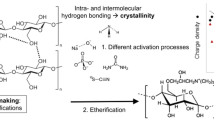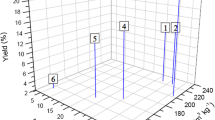Abstract
A new chemo-enzymatic treatment is proposed to produce cellulosic fibers suitable for heterogeneous- or homogeneous-phase acetylation. The procedure included enzymatic (laccase–violuric acid) lignin removal from the precursor fibers (unbleached sulfite pulp) followed by hydrogen peroxide treatment. An optional intermediate stage included partial hydrolysis (endoglucanase) to increase fiber reactivity. The obtained “biobleached” fibers were acetylated in the heterogeneous phase with acetic anhydride in nonpolar solvents, yielding various acetyl group contents, depending on the severity of the reaction. The degree of acetylation was highly sensitive to the treatment conditions, mainly the acetic anhydride activity in the system. The results were compared to those obtained after acetylation of commercial, dissolving-grade fibers, used as reference. The effect of the inherent nature of the fibers tested were elucidated as far as hemicellulose content, fiber length, fine content and crystallinity. Acetyl group content of up to 24% were determined after heterogeneous reaction with the chemoenzymatic fibers. The substitution of hydroxyl groups by acetyl moieties resulted in a lower hydrophilicity, as assessed by measurement of the water contact angle. Homogeneous acetylation of the chemo-enzymatic and reference fibers resulted in relatively similar acetyl group content (up to 36 and 33%, respectively). These samples were soluble in acetone and produced transparent films (via solvent casting), with enhanced dry strength and lower hydrophilicity. Overall, it is concluded that the proposed chemo-enzymatic treatment is a feasible alternative for the production of fibers that are suitable for efficient acetylation.







Similar content being viewed by others
References
Ass BAP, Frollini E, Heinze T (2004) Studies on the homogeneous acetylation of cellulose in the novel solvent dimethyl sulfoxide/tetrabutylammonium fluoride trihydrate. Macromol Biosci 4:1008–1013. https://doi.org/10.1002/mabi.200400088
Barud HS, de Araújo Júnior AM, Santos DB et al (2008) Thermal behavior of cellulose acetate produced from homogeneous acetylation of bacterial cellulose. Thermochim Acta 471:61–69. https://doi.org/10.1016/j.tca.2008.02.009
Cao Y, Wu J, Meng T et al (2007) Acetone-soluble cellulose acetates prepared by one-step homogeneous acetylation of cornhusk cellulose in an ionic liquid 1-allyl-3-methylimidazolium chloride (AmimCl). Carbohydr Polym 69:665–672. https://doi.org/10.1016/j.carbpol.2007.02.001
Cunha AG, Zhou Q, Larsson PT, Berglund LA (2014) Topochemical acetylation of cellulose nanopaper structures for biocomposites: mechanisms for reduced water vapour sorption. Cellulose 21:2773–2787. https://doi.org/10.1007/s10570-014-0334-z
Cusola O, Valls C, Vidal T, Roncero MB (2013) Application of surface enzyme treatments using laccase and a hydrophobic compound to paper-based media. Bioresour Technol 131:521–526. https://doi.org/10.1016/j.biortech.2012.12.186
Engström A-C, Ek M, Henriksson G (2006) Improved accessibility and reactivity of dissolving pulp for the viscose process: pretreatment with monocomponent endoglucanase. Biomacromol 7:2027–2031
Ernest-Saunders R, Pawlak JJ, Lee JM (2014) Properties of surface acetylated microfibrillated cellulose relative to intra- and inter-fibril bonding. Cellulose 21:1541–1552. https://doi.org/10.1007/s10570-014-0177-7
FAO (2012) Food and Agriculture Organization of the United Nations. FAO, Rome
Fischer S, Thümmler K, Volkert B et al (2008) Properties and applications of cellulose acetate. Macromol Symp 262:89–96. https://doi.org/10.1002/masy.200850210
Fock W (1959) A modified method for determining the reactivity of viscose-grade dissolving pulps. Papier 13:92–95
Gehmayr V, Sixta H (2011) Dissolving pulp from enzyme treated kraft pulps for viscose application. Lenzing Ber 89:152–160
Janzon R, Puls J, Bohn A et al (2008a) Upgrading of paper grade pulps to dissolving pulps by nitren extraction: yields, molecular and supramolecular structures of nitren extracted pulps. Cellulose 15:739–750. https://doi.org/10.1007/s10570-008-9224-6
Janzon R, Saake B, Puls J (2008b) Upgrading of paper-grade pulps to dissolving pulps by nitren extraction: Properties of nitren extracted xylans in comparison to NaOH and KOH extracted xylans. Cellulose 15:161–175. https://doi.org/10.1007/s10570-007-9154-8
Jegannathan KR, Nielsen PH (2013) Environmental assessment of enzyme use in industrial production: a literature review. J Clean Prod 42:228–240. https://doi.org/10.1016/j.jclepro.2012.11.005
Kalia S, Boufi S, Celli A, Kango S (2014) Nanofibrillated cellulose: surface modification and potential applications. Colloid Polym Sci 292:5–31. https://doi.org/10.1007/s00396-013-3112-9
Köpcke V, Ibarra D, Ek M (2008) Increasing accessibility and reactivity of paper grade pulp by enzymatic treatment for use as dissolving pulp. Nord Pulp Pap Res J 23:363–368
Köpcke V, Ibarra D, Larsson PT, Ek M (2010) Optimization of treatment sequences for the production of dissolving pulp from birch kraft pulp. Nord Pulp Pap Res J 25:31–38
Krässig HA (1993) Cellulose-structure, accessibility and reactivity. Gordon and Breach Science Publisher, Yverdon
LaNieve HL, Richard K (2007) Handbook of fiber chemistry. In: Lewin M (ed) Cellulose acetate and triacetate fibers, 3rd edn. CRC Press, Boca Raton, pp 667–772
Luo P, Cao C, Liang Y et al (2013) Kinetic study of the acetylation of cotton linter pulp. BioResources 8:2708–2718. https://doi.org/10.15376/biores.8.2.2708-2718
Mashkour M, Afra E, Resalati H, Mashkour M (2015) Moderate surface acetylation of nanofibrillated cellulose for the improvement of paper strength and barrier properties. RSC Adv 5:60179–60187. https://doi.org/10.1039/c5ra08161k
Muhammad Djuned F, Asad M, Mohamad Ibrahim MN, Wan Daud WR (2014) Synthesis and characterization of cellulose acetate from TCF oil palm empty fruit bunch pulp. BioResources 9:4710–4721. https://doi.org/10.15376/biores.9.3.4710-4721
Quintana E, Valls C, Vidal T, Roncero MB (2013) An enzyme-catalysed bleaching treatment to meet dissolving pulp characteristics for cellulose derivatives applications. Bioresour Technol 148:1–8. https://doi.org/10.1016/j.biortech.2013.08.104
Quintana E, Valls C, Vidal T, Roncero MB (2015a) Comparative evaluation of the action of two different endoglucanases. Part II: on a biobleached acid sulphite pulp. Cellulose 22:2081–2093. https://doi.org/10.1007/s10570-015-0631-1
Quintana E, Valls C, Vidal T, Roncero MB (2015b) Comparative evaluation of the action of two different endoglucanases. Part I: on a fully bleached, commercial acid sulfite dissolving pulp. Cellulose 22:2067–2079. https://doi.org/10.1007/s10570-015-0623-1
Rodionova G, Lenes M, Eriksen Ø, Gregersen Ø (2011) Surface chemical modification of microfibrillated cellulose: improvement of barrier properties for packaging applications. Cellulose 18:127–134. https://doi.org/10.1007/s10570-010-9474-y
Roselli A, Hummel M, Monshizadeh A et al (2014) Ionic liquid extraction method for upgrading eucalyptus kraft pulp to high purity dissolving pulp. Cellulose 21:3655–3666. https://doi.org/10.1007/s10570-014-0344-x
Saka S, Matsumura H (2004) 2.3 Wood pulp manufacturing and quality characteristics. Macromol Symp 208:37–48. https://doi.org/10.1002/masy.200450404
Skals PB, Krabek A, Nielsen PH, Wenzel H (2008) Environmental assessment of enzyme assisted processing in pulp and paper industry. Int J Life Cycle Assess 13:124–132. https://doi.org/10.1065/lca2007.11.366
Steinmeier H (2004) Chemistry of cellulose acetylation. Macromol Symp 208:49–60. https://doi.org/10.1002/masy.200450405
Wan Daud WR, Djuned FM (2015) Cellulose acetate from oil palm empty fruit bunch via a one step heterogeneous acetylation. Carbohydr Polym 132:252–260. https://doi.org/10.1016/j.carbpol.2015.06.011
Zhi Fu G, Chan A, Minns D (2005) Preliminary assessment of the environmental benefits of enzyme bleaching for pulp and paper making (7 pp). Int J Life Cycle Assess 10:136–142. https://doi.org/10.1065/lca2004.06.162
Acknowledgments
The authors thank the ‘‘Ministerio de Economía y Competitividad’’ of Spain for their support in this work under the projects FILMBIOCEL CTQ2016-77936-R (funding also from the ‘‘Fondo Europeo de Desarrollo Regional FEDER’’) and MICROBIOCEL CTQ2017-84966-C2-1-R. The authors are grateful to the Serra Húnter Fellow to Cristina Valls. The authors would like to thank DOMSJÖ (Sweden) for providing the starting pulp. O.J.R. acknowledges funding support by the Academy of Finland through its Center of Excellence Program (2014–2019) “Molecular Engineering of Biosynthetic Hybrid Materials Research” (HYBER).
Author information
Authors and Affiliations
Corresponding authors
Electronic supplementary material
Below is the link to the electronic supplementary material.
Rights and permissions
About this article
Cite this article
Quintana, E., Ago, M., Valls, C. et al. Alternative chemo-enzymatic treatment for homogeneous and heterogeneous acetylation of wood fibers. Cellulose 25, 5323–5336 (2018). https://doi.org/10.1007/s10570-018-1947-4
Received:
Accepted:
Published:
Issue Date:
DOI: https://doi.org/10.1007/s10570-018-1947-4




